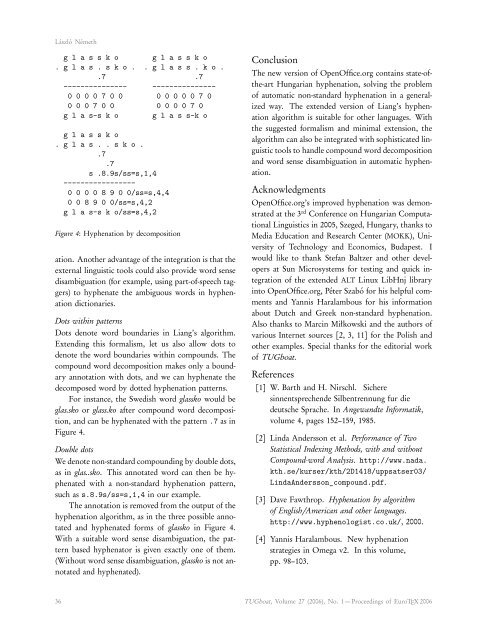The Communications of the TEX Users Group Volume 27 ... - TUG
The Communications of the TEX Users Group Volume 27 ... - TUG
The Communications of the TEX Users Group Volume 27 ... - TUG
Create successful ePaper yourself
Turn your PDF publications into a flip-book with our unique Google optimized e-Paper software.
László Németh<br />
g l a s s k o g l a s s k o<br />
. g l a s . s k o . . g l a s s . k o .<br />
.7 .7<br />
--------------- ---------------<br />
0 0 0 0 7 0 0 0 0 0 0 0 7 0<br />
0 0 0 7 0 0 0 0 0 0 7 0<br />
g l a s-s k o g l a s s-k o<br />
g l a s s k o<br />
. g l a s . . s k o .<br />
.7<br />
.7<br />
s .8.9s/ss=s,1,4<br />
-----------------<br />
0 0 0 0 8 9 0 0/ss=s,4,4<br />
0 0 8 9 0 0/ss=s,4,2<br />
g l a s-s k o/ss=s,4,2<br />
Figure 4: Hyphenation by decomposition<br />
ation. Ano<strong>the</strong>r advantage <strong>of</strong> <strong>the</strong> integration is that <strong>the</strong><br />
external linguistic tools could also provide word sense<br />
disambiguation (for example, using part-<strong>of</strong>-speech taggers)<br />
to hyphenate <strong>the</strong> ambiguous words in hyphenation<br />
dictionaries.<br />
Dots within patterns<br />
Dots denote word boundaries in Liang’s algorithm.<br />
Extending this formalism, let us also allow dots to<br />
denote <strong>the</strong> word boundaries within compounds. <strong>The</strong><br />
compound word decomposition makes only a boundary<br />
annotation with dots, and we can hyphenate <strong>the</strong><br />
decomposed word by dotted hyphenation patterns.<br />
For instance, <strong>the</strong> Swedish word glassko would be<br />
glas.sko or glass.ko after compound word decomposition,<br />
and can be hyphenated with <strong>the</strong> pattern .7 as in<br />
Figure 4.<br />
Double dots<br />
We denote non-standard compounding by double dots,<br />
as in glas..sko. This annotated word can <strong>the</strong>n be hyphenated<br />
with a non-standard hyphenation pattern,<br />
such as s.8.9s/ss=s,1,4 in our example.<br />
<strong>The</strong> annotation is removed from <strong>the</strong> output <strong>of</strong> <strong>the</strong><br />
hyphenation algorithm, as in <strong>the</strong> three possible annotated<br />
and hyphenated forms <strong>of</strong> glassko in Figure 4.<br />
With a suitable word sense disambiguation, <strong>the</strong> pattern<br />
based hyphenator is given exactly one <strong>of</strong> <strong>the</strong>m.<br />
(Without word sense disambiguation, glassko is not annotated<br />
and hyphenated).<br />
Conclusion<br />
<strong>The</strong> new version <strong>of</strong> OpenOffice.org contains state-<strong>of</strong><strong>the</strong>-art<br />
Hungarian hyphenation, solving <strong>the</strong> problem<br />
<strong>of</strong> automatic non-standard hyphenation in a generalized<br />
way. <strong>The</strong> extended version <strong>of</strong> Liang’s hyphenation<br />
algorithm is suitable for o<strong>the</strong>r languages. With<br />
<strong>the</strong> suggested formalism and minimal extension, <strong>the</strong><br />
algorithm can also be integrated with sophisticated linguistic<br />
tools to handle compound word decomposition<br />
and word sense disambiguation in automatic hyphenation.<br />
Acknowledgments<br />
OpenOffice.org’s improved hyphenation was demonstrated<br />
at <strong>the</strong> 3 rd Conference on Hungarian Computational<br />
Linguistics in 2005, Szeged, Hungary, thanks to<br />
Media Education and Research Center (MOKK), University<br />
<strong>of</strong> Technology and Economics, Budapest. I<br />
would like to thank Stefan Baltzer and o<strong>the</strong>r developers<br />
at Sun Microsystems for testing and quick integration<br />
<strong>of</strong> <strong>the</strong> extended ALT Linux LibHnj library<br />
into OpenOffice.org, Péter Szabó for his helpful comments<br />
and Yannis Haralambous for his information<br />
about Dutch and Greek non-standard hyphenation.<br />
Also thanks to Marcin Miłkowski and <strong>the</strong> authors <strong>of</strong><br />
various Internet sources[2, 3, 11] for <strong>the</strong> Polish and<br />
o<strong>the</strong>r examples. Special thanks for <strong>the</strong> editorial work<br />
<strong>of</strong> <strong>TUG</strong>boat.<br />
References<br />
[1] W. Barth and H. Nirschl. Sichere<br />
sinnentsprechende Silbentrennung fur die<br />
deutsche Sprache. In Angewandte Informatik,<br />
volume 4, pages 152–159, 1985.<br />
[2] Linda Andersson et al. Performance <strong>of</strong> Two<br />
Statistical Indexing Methods, with and without<br />
Compound-word Analysis. http://www.nada.<br />
kth.se/kurser/kth/2D1418/uppsatser03/<br />
LindaAndersson_compound.pdf.<br />
[3] Dave Fawthrop. Hyphenation by algorithm<br />
<strong>of</strong> English/American and o<strong>the</strong>r languages.<br />
http://www.hyphenologist.co.uk/, 2000.<br />
[4] Yannis Haralambous. New hyphenation<br />
strategies in Omega v2. In this volume,<br />
pp. 98–103.<br />
36 <strong>TUG</strong>boat, <strong>Volume</strong> <strong>27</strong> (2006), No. 1 — Proceedings <strong>of</strong> Euro<strong>TEX</strong> 2006

















